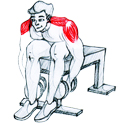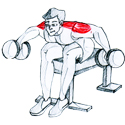-

|
-

|
| Step 1 |
Step 2 |
- Targeted Muscles:
- Rear shoulders (posterior deltoids)
- Middle back (rhomboids)
- Upper back (upper trapezius)
- The standing bent over lateral raise is a more advanced exercise because it requires you to maintain your balance and stability while lifting the weight. With your feet shoulder width apart, and your upper body at a 45-degree angle with the floor, perform the same arm movement as you would when seated.
- You can use a cable machine to work each side separately. Position a cable on a tower of a cable machine at the lowest setting and then attach a handle to the cable. Stand with your feet shoulder width apart, with one side of your body facing the tower. Then grip the handle with the hand furthest away from the cable. With your upper body at a 45-degree angle with the floor, perform the same arm movement as you would when seated. Repeat for your other side .
- The bent over lateral raise focuses on the muscles in the back of your shoulders and your middle and upper back. This exercise can make activities that involve lifting easier and can help improve your posture .
- Isolating the back of your shoulder muscles can help give your shoulders a more balanced appearance. Since this exercise works your shoulders, you should take care when performing this exercise if you have shoulder or neck problems .
- When performing the bent over lateral raise , there are several things you should keep in mind to maintain proper form. Make sure you bend forward from your hips and keep your back straight so that your upper body is parallel to the floor .
- As you lift the weight, you should maintain a slow, controlled arm movement and keep the rest of your body still. You may have to make a conscious effort to not raise your upper body as you lift the weight.
- Do not turn your head left or right or tilt your head up or down. Keep your head and neck in line with your body.
- Do not lock your elbows or raise them past your shoulders.
- Do not hunch your back or move your upper body as you raise and lower the dumbbells. Your back should be straight and your upper bosy should remain parallel to the floor.
|











